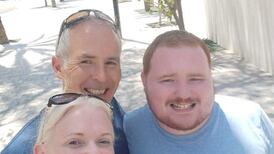When John Gilligan takes his first steps of freedom this morning, he will be re-entering a society where the criminal underworld is very different to the one he once dominated.
It is a new world of ultra gun violence where his profile and reputation will not protect him as it once did. The Dubliner has been in prison for just over 17 years, with many newer gangs having committed between 10 and 15 gun murders apiece in the past decade alone; a body count unheard of in Gilligan’s heyday.
Gilligan is now 61 years old and how he would cope if he tried to carve out a niche for himself at the top end of organised drug trafficking is unknown.
His wife Geraldine still lives in a house beside the Jessbrook lands and showjumping arena near Johnstownbridge on the border between Kildare and Meath. They were trying to launch it as an international competitive facility at the time he was jailed pending trial for the murder of journalist Veronica Guerin and drug dealing.
He was cleared of the Sunday Independent journalist's murder but was jailed for 28 years for drug dealing; the longest ever sentence handed down by an Irish court for a drugs offence.
That sentence was subsequently reduced on appeal to 20 years.
The man who is believed to have fired the shots that killed Veronica Guerin, Patrick Eugene Holland, died in prison in the UK in 2009 after being jailed there for kidnapping. Paul "Hippo" Ward (49) was one of two men convicted of the murder but that was overturned on appeal. He became involved in a serious riot in jail pending that appeal and was jailed for 12 years for it, being released in 2005. He still lives in Dublin.
The only other man convicted of the murder was Brian Meehan, who is serving life for the crime. Gilligan's close friend and adviser John Traynor now lives in the UK while another gang member Peter "Fatso" Mitchell also appears to be living a quieter life in the Netherlands.
Gangland prison
Gilligan has spent his years in prison on the E1 landing of Portlaoise Prison where gangland criminals are housed. He has gotten to know a large number of serious criminals who passed through the landing during his time there, and having met his old gang mates in jail in the early 1990s it is not inconceivable that on release he will fall back on friendships made when in jail.
“He will have made a few enemies in jail as well because he always tried to be a big personality and some of the young ones would eat him without salt on the outside,” was one prison source’s blunt appraisal of Gilligan’s situation now.
The Garda force, at least some of whom feared Gilligan in the 1990s, is also much better at investigating and prosecuting gangland figures and has more experience in protecting its members in the face of threats from gang leaders.
Nevertheless, many Garda sources believe he still has significant finances hidden away abroad. Others believe a lot of his money was lost when the criminals he trusted to manage it were targeted by the Criminal Assets Bureau, introduced as a direct response to the shooting of Veronica Guerin.
Gilligan was born on March 29th, 1952; the fifth of 11 siblings. He spent his formative years in Ballyfermot and briefly worked at sea for B&I with his father in the mid 1960s. When he married and became a father he lived briefly in the North Strand area of north inner city Dublin before the family was housed in a council house on the Corduff estate in Blanchardstown.
By the 1970s he had abandoned any effort to make an honest living and was mixing with up-and-coming criminals such as the Dunne family, Martin “The General” Cahill and Martin “The Viper” Foley.
He specialised in crimes such as raids on bookmaker shops, hijacking trucks carrying valuable cargoes and robbing containers of their contents in Dublin docks.
In November 1993 he had just been set free on completion of a jail term for handling stolen property.
To that point, Gilligan’s criminal enterprises had developed to centre around robbing commercial premises, clearing them out and selling whatever the raids yielded. It was an unsophisticated enterprise in a country with only a fledgling drugs trade and one that earned him the nickname “Factory John”.
However, in 1993 he set about building a drugs empire that he hoped would make him rich and bring to his life the social mobility that he craved. He was to use the spoils of
his drug dealing to buy his way into the world of equestrian sport.
Biggest gang
Within three years he had built the biggest drugs gang the country had ever seen.
Veronica Guerin inquired doggedly into his affairs as he became wealthier. He physically assaulted her and he was set to stand trial for that crime. She was set to appear as a witness.
The public revulsion at the time of her murder in June 1996 led to the biggest Garda assault on organised crime ever seen, with Gilligan’s gang the key targets.
He fled the country in the aftermath of the killing, spending time in a number of countries including the Netherlands, but was extradited and held in jails for six years before his conviction for the drugs offence.
Despite the fact that his time in prison was lengthened by short terms for crimes committed in jail, his sentence has been served and he was due to walk free from Portlaoise Prison this morning.









